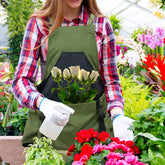How to Make a Potato Grow Bag: A Comprehensive Guide to Growing Potatoes Effortlessly
Table of Contents
- Introduction
- Why Choose a Potato Grow Bag?
- What You Will Need
- Constructing a Potato Grow Bag
- Planting Potatoes in Grow Bags
- Caring for Potato Plants in Grow Bags
- Harvesting Potatoes from Grow Bags
- Conclusion
- FAQ Section
Introduction
Have you ever wondered how to grow your own potatoes without the hassle of traditional gardening? The answer lies in the innovative and practical use of potato grow bags. These ingenious gardening solutions allow us to cultivate delicious, homegrown potatoes in a way that is not only efficient but also incredibly rewarding. With the rising popularity of container gardening, especially among urban dwellers and those with limited outdoor space, potato grow bags have become a favored choice.
At Garden Greenland, we understand the passion for gardening and the desire to connect with nature. Our journey began with a commitment to redefine the home gardening experience, ensuring everyone can embrace their green thumb. In this blog post, we will guide you through the process of making your own potato grow bag, discussing the materials, techniques, and benefits of this method. By the end of this article, you'll be equipped with the knowledge to successfully grow your own potatoes in bags, regardless of your gardening experience.
We will cover various aspects, including the reasons to use a grow bag, the materials needed, step-by-step instructions on constructing and planting in the bags, and tips for harvesting your potatoes. Let’s dive into this exciting gardening adventure together!
Why Choose a Potato Grow Bag?
Opting for a potato grow bag offers numerous advantages that can significantly enhance our gardening experience. Here’s why grow bags are an excellent choice for cultivating potatoes:
Space Efficiency
For those of us with limited garden space, potato grow bags allow us to maximize available areas. Whether we live in an apartment with a balcony or have a small backyard, these bags provide an easy way to grow potatoes without requiring vast plots of land.
Reduced Labor
Growing potatoes in bags minimizes the amount of digging and hilling typically associated with traditional potato cultivation. We can enjoy the fruits of our labor without the back-breaking work of turning soil or digging up tubers.
Improved Drainage
Potato grow bags provide excellent drainage, preventing waterlogging that can lead to rot. This is particularly important for potatoes, which thrive in well-drained soil. Our products, made from durable, weather-resistant materials, ensure that excess moisture escapes while retaining the necessary humidity for healthy growth.
Pest and Disease Management
By using grow bags, we can reduce the risk of soil-borne diseases and pests. This containment allows us to manage our plants more effectively, ensuring a healthier crop.
Enhanced Aeration
The breathable fabric of potato grow bags allows for better air circulation around the roots, promoting stronger growth and healthier plants. This design feature supports the development of robust root systems, leading to higher yields.
Incorporating potato grow bags into our gardening practices can bring numerous benefits, making the process of growing potatoes more accessible and enjoyable.
What You Will Need
To get started on our potato grow bag project, we will need a few essential materials and tools. Here’s what we’ll require:
Materials
- Grow Bag: We can either purchase a commercial potato grow bag or make our own from durable landscape fabric.
- Soil: A well-draining potting mix or compost-rich soil is ideal for growing potatoes.
- Seed Potatoes: Choose certified seed potatoes for best results. These are specially grown for planting and are free from diseases.
- Mulch: Organic mulch, such as straw or shredded leaves, can be used to protect the soil and retain moisture.
Tools
- Scissors or Utility Knife: For cutting the fabric if making our own grow bags.
- Measuring Tape: To ensure we cut the fabric to the correct size.
- Sewing Machine or Needle and Thread: If we decide to sew our grow bags, a sewing machine will make the process quicker, but hand-sewing is also an option.
- Watering Can: To keep our potato plants hydrated.
With our materials and tools ready, we can move on to the exciting part: constructing our potato grow bag!
Constructing a Potato Grow Bag
Creating our own potato grow bag is a straightforward process. Here’s a step-by-step guide to constructing a durable and functional grow bag.
Step 1: Measure and Cut the Fabric
Using our measuring tape, we can determine the size of our grow bag. A standard size is approximately 15 inches in diameter and 18 inches tall, but we can adjust these dimensions according to our needs.
- Cut a piece of landscape fabric into a rectangle measuring 36 inches by 18 inches.
- Fold the fabric in half lengthwise, bringing the two shorter edges together.
Step 2: Sew the Sides
- With the fabric folded, sew along the long edge, leaving the top open. This will create a cylindrical shape.
- To enhance stability, we can sew a second seam about half an inch from the first.
Step 3: Create the Bottom
- Cut a square piece of fabric for the bottom, measuring 15 inches by 15 inches.
- Attach this bottom piece to the open end of the cylinder, ensuring it is securely sewn in place.
Step 4: Add Drainage Holes
To prevent water from pooling at the bottom, we need to create drainage holes:
- Use scissors or a utility knife to cut several small slits in the bottom of the bag. This allows excess water to escape while retaining moisture for the plants.
Step 5: Final Touches
- Turn the bag inside out to hide the seams, and our potato grow bag is ready for use!
Creating our own grow bag not only saves money but also allows us to customize it according to our gardening needs.
Planting Potatoes in Grow Bags
Now that we have our potato grow bags ready, it’s time to plant our seed potatoes. Here’s how we can do it effectively:
Step 1: Prepare the Soil
Fill the bottom of the grow bag with a few inches of soil, allowing for proper drainage at the bottom.
Step 2: Place the Seed Potatoes
- Cut the seed potatoes into pieces, ensuring each piece has at least one eye.
- Lay the seed potato pieces on top of the soil, spacing them evenly apart—typically, we can fit about 3-4 pieces in a standard grow bag.
Step 3: Cover with Soil
Cover the seed potatoes with another layer of soil, approximately 4-6 inches deep.
Step 4: Water Generously
After planting, we need to water the grow bag thoroughly. This hydration will support the initial growth of the potatoes.
Step 5: Add Mulch
To retain moisture and prevent weeds, we can add a layer of organic mulch on top of the soil. This mulch will break down over time, enriching the soil as the plants grow.
With our potatoes planted, we can now focus on caring for them as they grow.
Caring for Potato Plants in Grow Bags
Successful potato cultivation requires consistent care and attention. Here are essential tips for maintaining our potato grow bags:
Watering
Potatoes require consistent moisture, especially during the growing season. We should check the soil regularly and water as needed, ensuring it remains damp but not soggy.
Fertilizing
To encourage healthy growth, we can fertilize our potato plants with a balanced organic fertilizer. Following the manufacturer’s instructions will ensure we do not over-fertilize, which can harm the plants.
Supporting Growth
As the potato plants mature, they will grow tall and may require support. We can gently roll down the sides of the grow bag to allow more room for growth, adding more mulch as needed.
Pest Management
Regularly inspect our potato plants for signs of pests, such as aphids or potato beetles. If pests are spotted, we can use organic pest control methods to eliminate them without harming our plants.
By focusing on these aspects, we can cultivate healthy potato plants that yield a bountiful harvest.
Harvesting Potatoes from Grow Bags
The moment we’ve all been waiting for arrives when it’s time to harvest our potatoes! Here’s how we can do it effectively:
Recognizing Harvest Time
Potatoes are typically ready to harvest 10 to 12 weeks after planting, particularly when the plants begin to flower. However, we can wait until the foliage starts to yellow and die back, indicating that the tubers have matured.
Harvesting Process
- Carefully tip over the grow bag, allowing the soil and potatoes to spill out.
- Gently sift through the soil to collect the potatoes, being cautious not to damage them.
- We can use any remaining soil in the bag for future plantings or compost it.
Storing Potatoes
After harvesting, it’s essential to store our potatoes correctly to ensure their longevity:
- Allow the harvested potatoes to cure in a cool, dark place for about two weeks. This helps to toughen their skins and prolong storage life.
- Store them in a cardboard box or mesh bag in a cool, dark, and dry location.
With proper care and storage, we can enjoy our homegrown potatoes for months to come!
Conclusion
Growing potatoes in bags is a straightforward and rewarding gardening method that offers numerous benefits. From space efficiency to reduced labor, utilizing potato grow bags allows us to cultivate a delicious staple food with minimal effort.
At Garden Greenland, we are committed to helping you embrace your gardening journey. By providing high-quality, innovative gardening products, we strive to elevate every gardening experience. Our premium gardening supplies ensure you have the best tools at your disposal to nurture your plants successfully.
As we’ve explored in this article, making and using potato grow bags is a great way to enhance your gardening skills and enjoy the fruits of your labor. We encourage you to give it a try and experience the joy of harvesting your own homegrown potatoes.
FAQ Section
Q1: What type of potatoes should I use for planting in grow bags?
A1: It’s best to use certified seed potatoes, which are specifically grown for planting and are free from diseases. Choose varieties that you enjoy eating and that are suitable for your climate.
Q2: How many potatoes can I grow in one grow bag?
A2: Typically, you can grow 3-4 seed potato pieces in a standard-sized grow bag (15 inches in diameter). Adjust the number based on the size of your bag and the variety of potatoes.
Q3: How often should I water my potato grow bags?
A3: Potatoes need consistent moisture, so check the soil regularly. Water when the top inch of soil feels dry, ensuring the soil is damp but not soggy.
Q4: Can I reuse potato grow bags for another season?
A4: Yes, you can reuse grow bags as long as they are in good condition. Clean them thoroughly before planting new crops to prevent disease transfer.
Q5: Are there any pests I should watch out for when growing potatoes?
A5: Common pests include aphids, potato beetles, and wireworms. Regularly inspect your plants and use organic pest control methods if needed.
As we continue to connect with nature and enhance our gardening skills, let's embrace the joy of growing potatoes in our own bags. Happy gardening!









